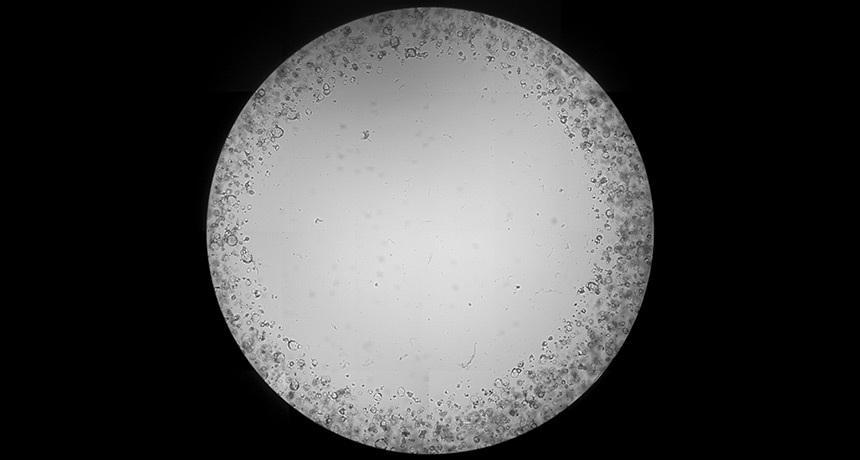Tumor ‘organoids’ may speed cancer treatment
A new method can quickly test hundreds of drugs on mini tumors grown from patients’ own cells

TUMOR IN A DISH By growing patients’ cancer cells into mini tumors (many of the round dots seen at the edge of this image) in the lab, researchers are developing methods to quickly identify potential drugs for rare, hard-to-treat cancers.
Alice Soragni
- More than 2 years ago
SAN DIEGO — Collecting cancer cells from patients and growing them into 3-D mini tumors could make it possible to quickly screen large numbers of potential drugs for ultra-rare cancers. Preliminary success with a new high-speed, high-volume approach is already guiding treatment decisions for some patients with recurring hard-to-treat cancers.
“Believe it or not, for some rare cancers there is no standard of care,” UCLA cancer biologist Alice Soragni said December 12 at a joint meeting of the American Society for Cell Biology and the European Molecular Biology Organization. “What if we could go back and tell the doctor, ‘Hey this combination of therapies worked really well for this specific patient?’”
In one case, Soragni and her colleagues tested 430 compounds on mini tumors grown from cells from a boy with a rare bone cancer. Eight of the compounds caused 75 percent cell death in the mini tumors — and those included cancer drugs not typically considered for his type of cancer, the team reported at the meeting.
While the boy is still responding well to standard chemotherapy, the approach could point to new treatments for patients running out of options. “If a candidate drug shows exciting activity and is [U.S. Food and Drug Administration] approved, then we would absolutely consider it,” says Noah Federman, who directs UCLA’s Pediatric Bone and Soft Tissue Sarcoma Program.
Earlier this year, a London-based team described how a “tumor-in-a-dish” approach successfully predicted drug responses in cancer patients who previously took part in clinical trials. That study was a major development in a new research area focused on “organoids” — tiny 3-D versions of the brain, gut, lung and other organs grown in the lab to probe basic biology or test drugs (SN: 3/3/18, p. 22).
“It makes sense to test cancer drugs on cancer cells outside the body first, before selecting the best one to be given to the patient,” says Hans Clevers, an organoid pioneer at the Hubrecht Institute in Utrecht, Netherlands. “This field will definitely grow rapidly,” says Clevers, who was not involved in the new study but has done similar research on treatments for rare kidney cancers.
Soragni and her colleagues have developed a high-volume, automated method to quickly study drug responses in tumor organoids grown from patient cells. By studying mini tumors grown on a plate with 96 tiny test tube–like wells, her team can screen hundreds of compounds at once and identify promising candidates within “a time frame that is therapeutically actionable — one to two weeks from surgery,” she said.
The method seemed to work for various kinds of ovarian cancer. The lab-grown organoids mimicked how tumors in the body look and behave. And even in cases when mini tumors had a tough time growing in a dish, scientists still identified potential drug candidates.
Soragni’s team next tried the organoid screening method with sarcomas — a rare group of particularly hard-to-treat cancers that arise in bones or connective tissue and often spread to the lungs. Team member and UCLA thoracic surgeon Jane Yanagawa suggested the new target because she sometimes performs multiple surgeries in the same sarcoma patient for recurring lung tumors. “I was frustrated … and feeling like there had to be more that I could do for them,” she says.
About a year ago, she approached Soragni about growing patients’ resected tumors for high-throughput drug screening. So far, the UCLA team has produced organoids from 35 to 40 people with various types of sarcoma, including from the boy with the rare bone cancer, an 11-year-old diagnosed with small cell osteosarcoma, which affects barely a dozen kids in the United States each year.
Of the eight drugs that worked in the boy’s tumor organoids, four were so-called “CDK inhibitors” — a group of therapies doctors would not ordinarily consider for treating osteosarcoma, Federman says. Organoid screens can also identify tumors that won’t respond to conventional therapy, he says. This could prove especially useful for people with recurring metastases, where it’s “not clear if we’re doing anything for their overall survival or giving them more toxicity.”







